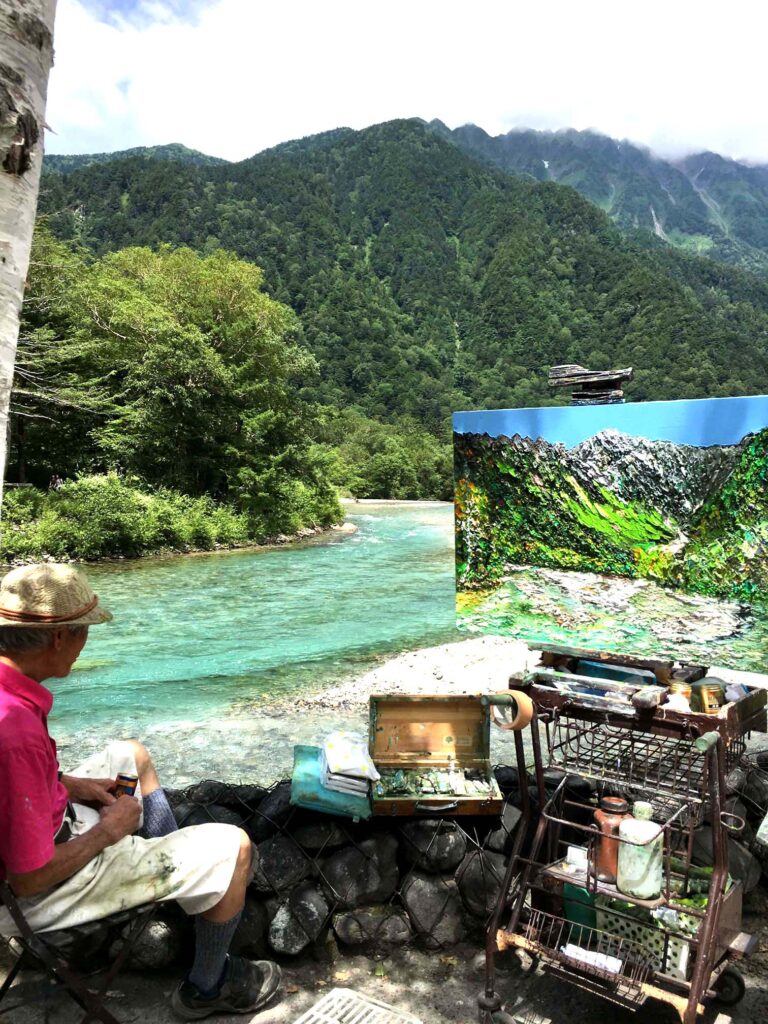
Seven years ago, in the summer of 2017, thinking that my legs had weakened and I might not be able to make such a trip again, I made a significant decision to visit Kamikōchi, a place full of memories. In the past, the only way to enter was from Matsumoto City in Nagano Prefecture, but now it’s much easier as you can enter from Hirayu Onsen in Gifu Prefecture. I took a shuttle bus from Hirayu and got off at the Taishō Pond bus stop, the entrance to Kamikōchi. As you descend the steps in front of the bus stop, the breathtaking view of Taishō Pond unfolds before your eyes. Beyond the pond, Mount Yake looms.
From here, it’s about a 4 km journey to Kappa Bridge. After walking for about 20–30 minutes from Taishō Pond, the view suddenly opens up, revealing the Tashiro Marsh spreading out before you. Beyond the marsh, you can catch a distant view of Mount Okuhotaka, the symbol of Kamikōchi. The feeling of standing at the summit resurfaces. Passing through the Tashiro Marsh, the trail splits into two: the “Azusa River Course” and the “Woodland Course.” I chose the “Azusa River Course.” Along the way, there are several signs warning, “Beware of bears!” The clear streams and the sound of babbling water evoke a deep sense of nostalgia. I still vividly remember the delicious taste of powdered juice mixed with the water from the Azusa River.
Continuing on, I crossed Tashiro Bridge and followed the right bank route along the Azusa River. There, a relief of the British missionary Walter Weston, who introduced the beauty of Kamikōchi to the world, is displayed, and now many accommodations, including Kamikōchi Alpen Hotel, have been built in the area. After walking for about 10 more minutes, Kappa Bridge comes into view. Standing on the bridge, you can see Mount Okuhotaka and Mount Myōjin. The course from Taishō Pond to Kappa Bridge takes about two hours if you walk leisurely, but it probably took me three hours.
As I crossed the bridge, I saw an old painter drawing at the foot of the bridge. After finishing his painting, he was drinking coffee. When I spoke to him, he kindly pulled out a folding cloth chair and offered me coffee, and we lost track of time as we reminisced.
今から7年前の2017年の夏、もう足腰も弱ってこの先行くこともないだろうと思って一大決心、思い出深い上高地を訪ねることにしました。昔は長野県の松本市からしか入れなかったのですが、今は岐阜県の平湯温泉から入れるので随分楽になりました。平湯からシャトルバスに乗って、上高地の入口、大正池のバス停を降りました。バス停前の階段を降りると大正池の絶景が目に飛び込んできます。池の向こうには焼岳が聳えています。
ここから河童橋まではおよそ4km程の工程です。大正池から20~30分ほど歩くと、急に視界が開け、目の前に田代湿原が広がります。湿原の向こうには上高地のシンボルとも言える奥穂高岳が遠望できます。あの頂に立った時の感動が蘇ります。田代湿原を抜けると、ここからは「梓川コース」と「林間コース」の2手にコースが分かれますが、「梓川コース」を選びました。途中には「クマにご注意!」の看板が何か所にも立っています。昔ながらの清流とそのせせらぎの音はいっそうの感懐を呼び起こします。粉末ジュースを梓川の水に溶かして飲んだ美味しさは今もはっきり覚えています。
しばらく進んで田代橋を渡り、右岸ルートを梓川沿いに進むと、上高地の魅力を世界に発信したイギリス人宣教師ウェストン氏のレリーフがあり、上高地アルペンホテルをはじめとした宿泊施設が今ではたくさん立っています。進むこと10分ほどで河童橋が見えてきます。橋に立って梓川の上流に目をやると奥穂高岳や明神岳などを望むことができます。大正池から河童橋まで、ゆっくり歩いても2時間ほどのコースですが、3時間は掛ったでしょうか。
橋を渡ると、橋のたもとで絵を描いている老画家がいました。絵を描き終えてコーヒーを飲んでいました。声をかけると、人懐かしそうに布製の折りたたみ椅子を出してくれ、コーヒーを進めてくれ、時間の経つのも忘れて思い出話に花を咲かせました。
